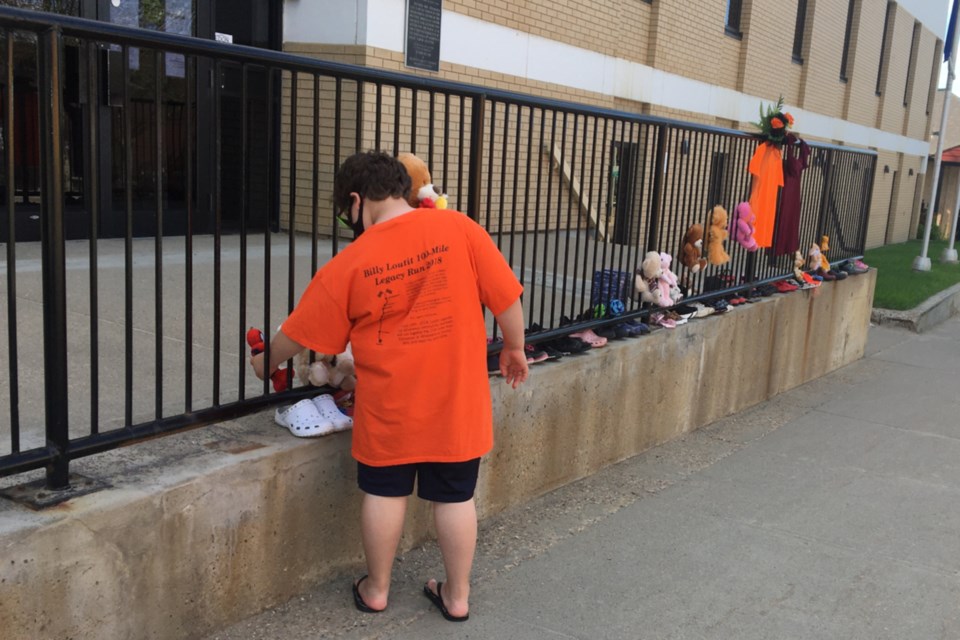ATHABASCA — Residential schools are a painful and shameful piece of Canadian history many would like to put behind them, but the need for truth and reconciliation and the question of how to move forward are at the forefront once again after the discovery of 215 unmarked children’s graves at what was once the largest such facility in the country.
From the 1830s until the last school closed in 1996 in Saskatchewan, more than 150,000 Indigenous children were required to attend Christian-run residential schools across Canada, including the Kamloops Indian Residential School, which was the site of the grisly discovery announced May 27.
Alma Swan is a First Nations, Métis and Inuit student counselor in Athabasca and is also a member of the Bigstone Cree Nation. While she did not attend a residential school herself, she knows many who did, and has seen the results of the trauma that occurred there.
“I'm not the be all, the end all, but I'm a generational survivor of residential schools. My mom was in a residential school for 11 years and I have an aunt … she was in a residential school I think for about eight years. She only went home three times (in eight years),” said Swan in an interview June 2.
“There's lots of people out there that still think – or have the attitude – that we should just get over it and I think that some of those people are changing their mind,” she said. “And I think the more we learn about residential school and their impacts, I think the more people – the non-believers – are starting to say, 'Well, I guess it was worse than I thought.'"
Swan has been watching social media and the news since the start of the pandemic and noticed many people claiming their rights were being taken away, but these children, and their families are the ones who had their rights taken away
“You’re complaining about this, about losing your freedoms, but what about these children?”
She said there are many things non-Indigenous people can do to support survivors and Indigenous people in general, but it all starts with acknowledging terrible things happened to children in those places, as well as recognizing the impact having their children taken from them had on the parents.
“So, I think acknowledging Indigenous Peoples Day coming up on the 21st – we need to do that throughout the year, not just on June 21 – and continue with the Orange Shirt Day (Sept. 30), and continue with acknowledging the unsafe drinking water for so many First Nations communities, and keep acknowledging the inequity in general.”
Another key element is education, said Swan, not just accepting what was vaguely taught in school, but having some empathy for other human beings.
“Once you get educated then acknowledge that it did happen and really think about what the impacts are when you think about your own family,” she said. “How could that have impacted me if I was ripped away from my parents, and only saw them once a year? If I never, ever got a hug? If I never, ever got somebody to acknowledge my gifts?”
Those gifts included the many Indigenous cultures and languages that were spread across the country, many of which were nearly wiped out entirely, but some are slowly having a revival.
Swan also noted Alberta Education does not have a Cree language course, meaning schools have to create their own, just like the school in Calling Lake did. The Kee Tas Kee Now Tribal Council Education Authority (KTCEA) which is the education authority for six schools within five Cree First Nations – Loon River, Woodland Cree, Lubicon Lake Band, Whitefish Lake and Peerless Trout First Nations – has also created a Cree language app anyone can download.
Swan suspects many residential schools have similar graves and was grateful to hear the Alberta Government announce May 31 that money would be budgeted to search former residential school grounds, but she has doubts it will yield much, as many have been built over for decades already.
The National Truth and Reconciliation Commission has record of at least 51 children dying at the Kamloops school between 1914 and 1963, noting in its 2015 report that as early as 1918 officials believed the children were inadequately fed and malnourished.
“I’ve seen some pictures of babies in residential schools,” she said. “Can you imagine the impact on babies in residential schools?”
At least 4,100 children are known to have died at residential schools across Canada.
“I'm glad that people are at least acknowledging it and acknowledging that this was a horrendous part of our history,” she said. “I talked to my grand kids and they just couldn't believe it. They asked how people could do that to kids?”
If you are a former residential school survivor or have been affected by the residential school system and need help, you can contact the 24-hour Canadian Indian Residential Schools Crisis Line at 1-866-925-4419.
Read more from TownandCountryToday.com



